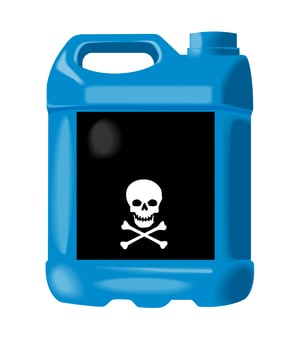Businesses in a wide range of industries and fields work with poisonous substances on a daily basis to produce products that help people live better lives.
Because poisonous or toxic materials may be an everyday reality at your business, proper hazardous waste removal and disposal should be a top priority for you.
Below, we’ll explore some of the most frequent questions that address:
- What Class 6 poisons are,
- How they should be disposed of, and
- Why it’s important to dispose of them properly.
What are Class 6 Poisons?
Poisons are a broad category of hazardous toxic materials that can cause serious health issues or death in humans. Class 6 poisons, in particular, include two subdivisions:
- Division 6.1: Toxic substances
- Division 6.2: Infectious substances
Division 6.1
Division 6.1 includes toxic substances, poisons and irritating materials. Examples include bromobenzyl cyanide, methyl bromide and tear gas.
There are three kinds of toxicity that are often used to describe Division 6.1 substances that can help to identify a poison:
- Oral toxicity: Poisons with oral toxicity are only toxic when ingested orally.
- Dermal toxicity: Dermal toxicity means the poison is dangerous when it comes into contact with the skin.
- Inhalation toxicity: Inhalation toxicity means that the poison produces a vapor, dust or mist that can be toxic.
Irritating materials, such as tear gas, give off intense fumes and can cause the eyes, nose and throat to be irritated. However, these substances typically are reversible and only impair a person temporarily.
Division 6.2
Division 6.2 includes infectious substances, which means they are a material that can contain a pathogen. Pathogens can include bacteria, viruses, fungi or other infectious substances.
When packing and shipping infectious Division 6.2 substances, they must be assigned to a category:
- Category A: This includes infectious substances transported in a form capable of causing permanent disability or is life threatening when exposure occurs.
- Category B: This includes any substance that does not meet the criteria of Category A.
Other examples of Division 6.2 substances include biological products, regulated medical waste, used healthcare products and forensic materials.
How Should They Be Disposed Of?
Improper disposal of hazardous waste can take many different forms. One of the most basic and common forms of improper waste disposal for poisonous materials is failing to store and label the waste.
All poisons should be stored to meet federal guidelines enforced by the Department of Transportation. Shipping requirements when transporting these hazardous materials, may include:
- A shipping manifest: In 2018, the Environmental Protection Agency began implementing a national e-manifest system that tracks hazardous waste shipments electronically. For several decades, the EPA has imposed a manifest system that tracks cradle-to-grave hazardous waste.
- The proper hazardous waste labels and placards: The DOT requires hazardous waste generators to label and mark each package of waste before transporting off site. The Class 6 placard, in particular, features a symbol that shows either a skull and crossbones or a biohazard symbol, depending on the division and hazard. It’s important to note that for regulated medical waste may have different outer packaging requirements.
- California requirements: The California Department of Toxic Substances Control (DTSC) also provides its own set of requirements that generators must follow, including:
- The composition and physical state of the waste
- A statement that calls attention to the hazardous properties of the waste
- Name and address of the generator
Poisons should be transported to a waste disposal facility, where they are processed by certified waste disposal professionals.
Why Dispose Of Professionally?
Disposing of hazardous waste, including Class 6 poisons, is critical to following federal and state regulations, and keeping the public and environment safe. The U.S. Department of Transportation, EPA and the California DTSC prohibit this type of hazardous waste from being disposed of as normal waste.
That’s because exposure to Class 6 poisons can result in serious illnesses, infectious diseases, traumatic injuries and even death. It is important to limit your organization’s liability and expenses in the event of a hazardous waste exposure.
While most hazardous waste generators are aware that they have responsibilities to safely dispose of their waste, many fail to realize there are “complete” cradle to grave requirements they must follow. To stay in compliance with the Resource Conservation and Recovery Act (RCRA), generators are responsible for the hazardous waste they produce from its initial generation, its transportation and to its final disposal.
Hiring a hazardous waste removal service is beneficial for a number of reasons. Working from one:
- Eliminates your liability for disposing of wastes since you’ve hired a trusted, professional service.
- Minimizes the risk of contaminating your workplace and environment, which means your employees will be kept safe.
- Assists you with staying on top of government regulation changes that can affect your ability to do your job effectively.
- Improves your workflow, reduces expenses and allows you to do the job you were hired to do more effectively.
If you’re a company that uses Class 6 poisons, it’s important that you properly label, store, transport and dispose of these substances. A hazardous waste removal service can assist you with these critical tasks, allowing you to focus on the day-to-day operations of your business and its future.



Comment